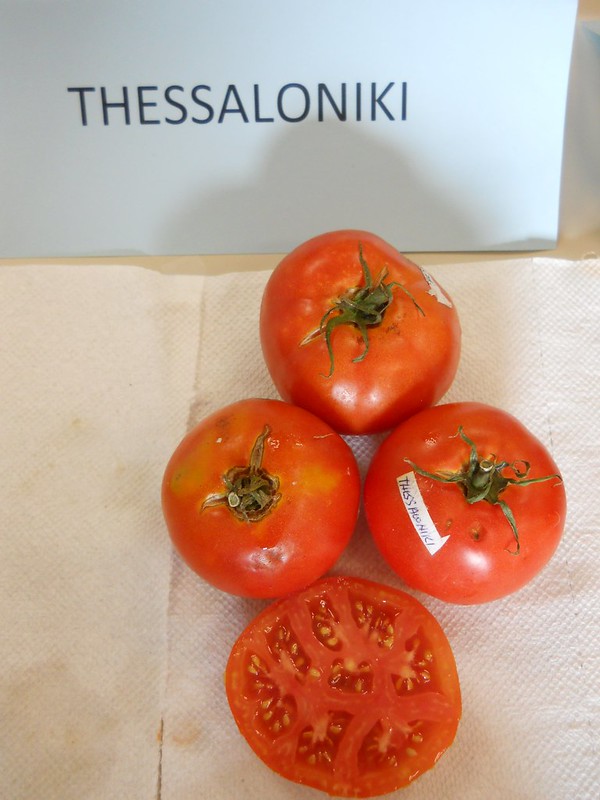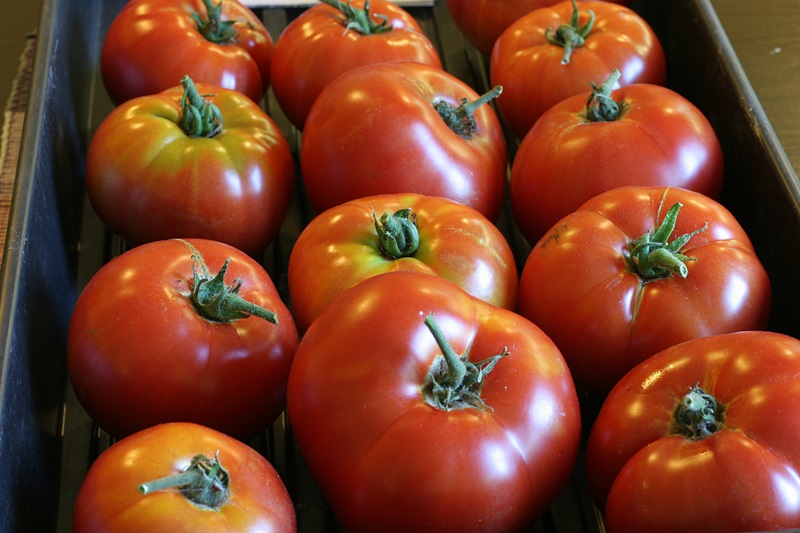Tomatoes are the quintessential summer vegetable, but they can’t take extreme heat. When daytime temperatures are consistently above 90°F (32°C) you can start to see yield problems. Blossom drop, aborted fruits, blossom end rot, and cracked tomatoes are all problems gardeners face especially in hot and dry climates. While there are several strategies you can use (see below) to increase your chances of success, one thing you can and should try is growing heat-tolerant (also called hot-set or heat-set) tomato varieties.
Below are some of the best tomatoes to grow in hot, dry climates, although some do equally well in humid climates, too.
| Tomato Variety | Type | Heat Tolerance | Additional Notes |
|---|---|---|---|
| Early Girl | Indeterminate, Hybrid | Very High | Ideal for dry climates |
| Phoenix | Determinate, Hybrid | Extremely High | Good for both dry/humid climates |
| Thessaloniki | Indeterminate, OP | Very High | Ideal for dry climates |
| Abu Rawan | Determinate, OP | Very High | Ideal for dry climates |
| Arkansas Traveler | Indeterminate, OP | High | Good for both dry/humid climates |
| Celebrity | Determinate, Hybrid | High | Good for both dry/humid climates |
| Flamenco | Semi-determinate, OP | Extremely High | Ideal for dry climates |
| Chadwick Cherry | Indeterminate, OP | Extremely High | Cherry tomato; good for both dry/humid climates |
| Siletz | Determinate, OP | High | Parthenocarpic; good for both dry/humid climates |
Note to international readers: Many of the US-based seed companies mentioned in this article also ship internationally.
On this page:
Best Tomato Varieties for Hot, Dry Climates
Early Girl
An all-around early, prolific performer for any climate, but does exceptionally well in dry heat
Heat Tolerance: Very High, excellent for dry climates
Growth Habit: Indeterminate
Days to Maturity: 60 days
Fruit Description: Red, medium-sized, 4-8 oz
Open Pollinated? No (Hybrid)
Get seeds: Burpee (US), Park Seed (US), Johnny’s Selected Seeds (US), Ferry Morse (US), West Coast Seeds (Canada), T&T Seeds (Canada)
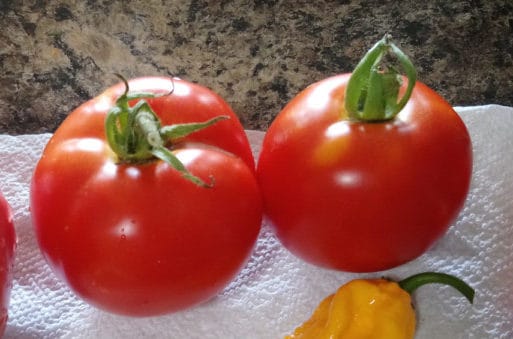
The Early Girl is a widely popular tomato variety for a range of climates. It’s grown all over for its very early maturity and consistently prolific yields, giving gardeners and commercial growers early harvests before frosts (in the north) and late-season disease (in the south).
But Early Girl tomatoes are especially prized in dry climates because of their ability to produce even more delicious tomatoes when grown in dry conditions. In what’s called dry farming, cultivators will plant Early Girl tomatoes very deep, burying several inches of the stem, allowing the roots to grow even deeper and access water when the surface is completely dry. The result is a harvest of exceptionally delicious tomatoes. Some farmers swear by dry farming Early Girl tomatoes. This technique does work best with clay subsoils that can hold onto water even as the topsoil has dried out. You can read more about dry-farmed Early Girl tomatoes here.
The fruits themselves are typical red slicers with a slightly tart taste (enhanced if grown in dry conditions), fairly thin skins, uniform shape, and are resistant to cracking. Not the most heat tolerant but a solid choice no matter where you are.
Phoenix
Compact, prolific bush tomato with superb heat tolerance and excellent disease resistance
Heat Tolerance: Extremely High; good for both dry and humid climates
Growth Habit: Determinate (Bush)
Days to Maturity: 70-75 days
Fruit Description: Red, medium-large, 8+ oz
Open Pollinated? No (Hybrid)
Get seeds: True Leaf Market (US), Seedway (US), Tomato Growers (US), Willhite Seed (US), Seeds ‘n Such (US)
The Phoenix tomato was bred specifically for resisting the searing heat of places like Arizona and South Texas. This variety produces trusses of plump, crimson red tomatoes on a relatively compact but vigorous plant. Not only does the Phoenix have exceptional heat tolerance, it’s crack resistant for those sudden heavy rains, and is resistant to multiple fungal diseases (Verticillium Wilt, Fusarium Wilt, and Anthracnose). This makes it also ideal for more humid, disease-prone regions.
If you’ve tried other heat tolerant varieties and didn’t have much luck, the (aptly named) Phoenix tomato should be on your must-grow list to try. Excellent for both home gardeners and market growers.
Thessaloniki Tomato
A reliable Greek heirloom tomato that resists sunburn and cracking
Heat Tolerance: Very High, excellent for dry climates
Growth Habit: Indeterminate
Days to Maturity: 75-80 days
Fruit Description: Red, medium-sized, 5-8 oz
Open Pollinated? Yes
Get seeds: Victory Seeds (US), Totally Tomato (US), TomatoFest (US), True Leaf Market (US), The Seedstead (US), Everwilde Farms (US), Premier Seeds Direct (UK), Kings Seeds (NZ)
An old heirloom well-adapted to the Mediterranean heat, the Thessaloniki tomato is a productive, resilient variety perfect for dry climates. The variety was introduced to the US in the 1950s from Greece and was favored by market growers due to its natural drought tolerance and solid production of uniform tomatoes until more productive hybrids became the norm.
The tomatoes themselves are deep red, 5-8 oz fruits with a slightly sweet and tart flavor profile. Probably one of the best choices for an indeterminate, medium-sized tomato in hot and dry regions like the Southwest. Highly recommended.
Abu Rawan
A rare, delicious Iraqi heirloom that thrives in desert heat
Heat Tolerance: Extremely High, excellent for dry climates
Growth Habit: Determinate
Days to Maturity: 70-80 days
Fruit Description: Red, small-medium, 2-4 oz
Open Pollinated? Yes
Get seeds: Baker Creek (US), Victory Seeds (US), Two Seeds in a Pod (US)
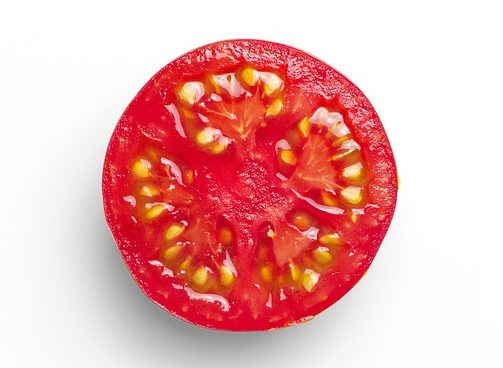
Abu Rawan is one of the few tomato varieties that has been cultivated specifically for the desert. This variety has been grown around the area of Baghdad (which gets around 6 inches of rain a year) since the 1970s, and was introduced to the US by an Iraqi seed collector. Along with Abu Rawan, there are other Iraqi tomato varieties such as Basrawya and Al-Kuffa, both of which are also excellent for hot and dry climates.
The tomatoes themselves are on the small side, maxing out at around 4 oz, but are flavorful and juicy, with both a sweet and acidic bite. Highly recommended.
Arkansas Traveler
A prolific producer that is resistant to heat, drought, and humidity
Heat Tolerance: High; good for both dry and humid climates
Growth Habit: Indeterminate
Days to Maturity: 85-90 days
Fruit Description: Reddish pink, medium-sized, 6-8 oz
Open Pollinated? Yes
Get seeds: Victory Seeds (US), Totally Tomatoes (US), MIGardener (US), Burpee (US), TomatoFest (US), True Leaf Market (US)
Who says heirlooms can’t have heat tolerance? The Arkansas Traveler is an open-pollinated slicing tomato that is a dependable and prolific variety for any Southern garden. The Arkansas Traveler thrives in hot, dry weather, and its natural disease resistance makes it suitable for humid climates, too. You can expect the Arkansas Traveler to produce long after other less hardy heirlooms have slowed down.
Producing clusters of medium-sized pink-red tomatoes, the taste is often described as mild but flavorful. A reliable producer and popular variety.
Celebrity
A productive, heat-tolerant, disease-resistant bush tomato cherished by market growers for decades; an AAS winner since 1984
Heat Tolerance: High; good for both dry and humid climates
Growth Habit: Determinate
Days to Maturity: 70-75 days
Fruit Description: Red, medium-large, 8-10 oz
Open Pollinated? No (Hybrid)
Get seeds: Johnny’s Selected Seeds (US), Burpee (US), Harris Seeds (US), True Leaf Market (US), Hoss Tools (US), Park Seed (US), UF Seeds (US), Stokes Seeds (Canada), OSC Seeds (Canada)
The appropriately named Celebrity tomato has been the go-to bush tomato variety for production for both market growers and home gardeners since it was introduced in the 1980s. Celebrity is prized for its ability to produce large flushes of medium-large tomatoes in a wide variety of environments, including hot, dry weather.
Because of its prolific yields of uniform, firm, flavorful tomatoes, it was deemed an All-America Selections winner in 1984. To this day, Celebrity is a widely popular variety across the country.
Flamenco
An obscure but highly productive heat-set tomato that thrives in low and high desert regions
Heat Tolerance: Extremely High, excellent for dry climates
Growth Habit: Semi-determinate
Days to Maturity: 60-75 days
Fruit Description: Red, small-medium (2-inch fruits)
Open Pollinated? Yes
Get seeds: Native Seeds (US), Heritage Seed Market (US), Giving Ground Seeds (US)
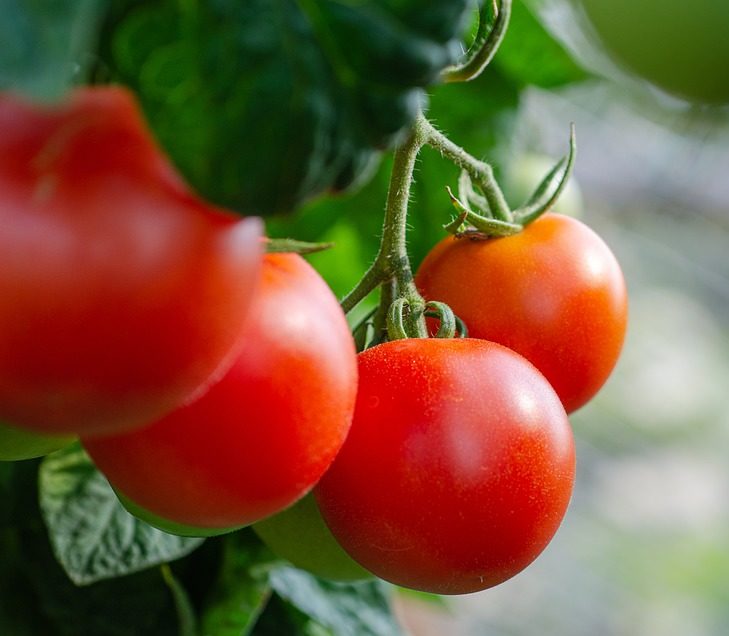
Another smallish tomato, the Flamenco is one of the most heat-tolerant varieties in this list. It thrives in the Arizona heat, producing long after other varieties have given up. It’s an open pollinated variety but was originally a cross between early-bearing and a heat tolerant varieties. The result is an incredible little tomato variety that grows as a compact, semi-determinate plant.
It’s not an easy to find variety, but as it’s open pollinated, if you isolate some of the blossoms you can save the seeds from those tomatoes and replant them the following year.
Flamenco tomatoes are well-balanced in flavor and very juicy for their size. Highly recommended.
Chadwick Cherry
A prolific cherry tomato variety that sets fruit at over 110°F (43°C)
Heat Tolerance: Extremely High, good for both dry and humid climates
Growth Habit: Indeterminate
Days to Maturity: 75-80 days
Fruit Description: Red, large cherry, 1 oz
Open Pollinated? Yes
Get seeds: Baker Creek (US), Burpee (US), TomatoFest (US), Premier Seeds Direct (UK)
Most cherry tomato varieties actually do well in the heat, so if you want to grow cherries, most productive varieties will yield well even in the dry Southwest. However, some cherry tomatoes grow exceptionally well in the heat, and Chadwick Cherry is one of them. Some gardeners have reported it setting fruit at temperatures higher than 110°F (43°C)!
Producing abundant clusters of large, 1-oz cherry tomatoes, the Chadwick Cherries burst with flavor when you bite into one. A disease-resistant variety, the Chadwick will keep producing much longer than other heirloom tomato varieties.
Siletz
A parthenocarpic tomato that produces heavy yields of tomatoes
Heat Tolerance: High, good for both dry and humid climates
Growth Habit: Determinate (Bush)
Days to Maturity: 55-65 days
Fruit Description: Red, large, 8-16 oz
Open Pollinated? Yes
Get seeds: Victory Seeds (US), Seeds ‘n Such (US), Adaptive Seeds (US), Territorial Seed Company (US), TomatoFest (US), West Coast Seeds (Canada), Wildrose Heritage Seed Company (Canada), Saanich Organics (Canada)
Siletz is a classic red slicer that can get large enough to be confused for a beefsteak. Each bushy plant produces prolific yields of relatively uniform tomatoes. The tomatoes can come very early in the season, and still have great flavor. Siletz also has decent disease resistance against Verticillium Wilt and Fusarium Wilt.
This tomato variety’s claim to fame is the fact that it’s parthenocarpic, which means it can produce tomatoes without pollination. Tomatoes are known to have reduced pollination when daytime temperatures are consistently above 90°F (32°C). As with all parthenocarpic vegetables, like some parthenocarpic cucumbers and zucchinis, unpollinated fruit development won’t happen 100% of the time, but having the ability to fruit even when temperatures are too hot (or cold) can be invaluable insurance. Also, parthenocarpic fruits end up seedless!
Other Great Tomato Varieties for the Heat
As a rule of thumb, cherry tomatoes and Roma-type tomatoes tend to perform better in the heat than other types of tomatoes. Below are some varieties which do exceptionally well in the heat.
- Heatmaster
- Roma VF *
- Jetsetter
- Jetstar
- Solar Fire
- Legend
- Basrawya *
- Al-Kuffa *
- Sungold
- Porter’s Dark Cherry
* Particularly suitable for dry, hot climates
Strategies for Growing Tomatoes in the Heat
1. Grow heat-tolerant/heat-set varieties
The above list covers many of the best tomatoes to grow in hot and dry climates. These varieties can grow well in the heat as well as set fruit at high temperatures. As growing in extremely hot climates also comes with swings in water levels, these types of tomatoes are usually resistant to cracking as well.
As mentioned above, cherry and Roma-type tomatoes tend to naturally be more productive in the heat compared to other varieties, even if they are not specifically bred for heat tolerance.
2. Grow early varieties
In the north, early varieties are planted to get harvests before the first frost. Taking a page out of the northern gardeners’ book, you can plant early tomato varieties (like Early Girl or Celebrity) to get harvests before you reach the peak heat of the summer.
3. Use shade cloth and mulch
Even with heat-tolerant tomatoes, shade cloth is almost a necessity to keep your tomato plants from getting stressed from too much direct sun. Shade cloth is a mesh cloth (usually black or green but sometimes white or silver) which is designed to block a certain percentage of sunlight. 30-50% shade cloth is most commonly available. You can keep your shade cloth permanently over your tomatoes or only deploy it during heat waves or when you see your tomatoes getting overstressed.
Similarly, mulch is a must if you want to save water. Mulching your tomato plants reduces evaporation and protects the soil from being baked in the sun. Around 2 inches of straw or wood mulch is enough.
4. Avoid growing in the summer and grow in the “winter” or shoulder seasons instead
If you live in a hot, arid place like Arizona, you can sow tomatoes in winter or summer and grow them into the shoulder seasons. In hotter regions without true spring and fall weather, shoulder seasons are the times of year between the cooler “winters” and the hot summers.
The University of Arizona Extension offers some advice for desert tomato gardeners. For Arizona in particular, sowing your seeds early, in January, and transplanting in February while giving protection from potential early spring frosts can ensure you get months of harvests until the mid-summer heat kicks in.


